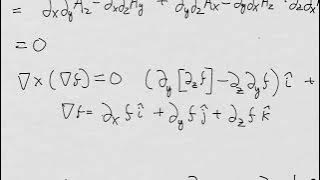
Mod-02 Lec-09 Potential and Potential Energy
Electromagnetic Theory by Prof. D.K. Ghosh,Department of Physics,IIT Bombay.For more details on NPTEL visit http://nptel.ac.in
From playlist IIT Bombay: Electromagnetic Theory

This video explains what is meant by electric potential and discusses why it is a purely location-dependent quantity. The video utilizes a gravitational analogy to answer the following question: What is electric potential and how is it related to electric potential energy? Link to the El
From playlist Electric Circuits

This video explains what is meant by electric potential and discusses why it is a purely location-dependent quantity. The video utilizes a gravitational analogy to answer the following question: What is electric potential and how is it related to electric potential energy? Link to the El
From playlist Electric Circuits

Mod-02 Lec-07 Gauss's Law, Potential
Electromagnetic Theory by Prof. D.K. Ghosh,Department of Physics,IIT Bombay.For more details on NPTEL visit http://nptel.ac.in
From playlist IIT Bombay: Electromagnetic Theory

Watch more videos on http://www.brightstorm.com/science/physics SUBSCRIBE FOR All OUR VIDEOS! https://www.youtube.com/subscription_center?add_user=brightstorm2 VISIT BRIGHTSTORM.com FOR TONS OF VIDEO TUTORIALS AND OTHER FEATURES! http://www.brightstorm.com/ LET'S CONNECT! Facebook ► htt
From playlist Physics

What is the Riemann Hypothesis?
This video provides a basic introduction to the Riemann Hypothesis based on the the superb book 'Prime Obsession' by John Derbyshire. Along the way I look at convergent and divergent series, Euler's famous solution to the Basel problem, and the Riemann-Zeta function. Analytic continuation
From playlist Mathematics

Field Equations: Potential Formulation of B
In this lesson we begin to review the potential formulation of the electric and magnetic fields. This video focuses on the potential formulation of the magnetic field. This involves a deep review of vector calculus and sets us up for the potential formulation of Maxwell's equations and an
From playlist QED- Prerequisite Topics

What is voltage and potential and how is it related to energy?
This video discusses the concept of potential, more commonly known as voltage, and its connection to energy.
From playlist Electricity and Magnetism

An extension of the single particle model considering the consequence of pairing of nuclei and whether the nuclear characteristics are dependent on the lone unpaired nucleon.
From playlist Nuclear Physics

Supersymmetric Gauge Dynamics, Part 1 - Nathan Seiberg
Supersymmetric Gauge Dynamics, Part 1 Nathan Seiberg Institute for Advanced Study July 21, 2010
From playlist PiTP 2010

Inflation and Supergravity - A. Linde - 5/17/2014
Workshop on Primordial Gravitational Waves and Cosmology (May 16 - 17, 2014) Learn more about this workshop: http://burkeinstitute.caltech.edu/workshops Produced in association with Caltech Academic Media Technologies. © 2014 California Institute of Technology
From playlist Walter Burke Institute for Theoretical Physics - Workshop on Primordial Gravitational Waves and Cosmology (May 16 - 17, 2014)

Giuseppe Mingione - 23 September 2016
Mingione, Giuseppe "Recent progresses in nonlinear potential theory"
From playlist A Mathematical Tribute to Ennio De Giorgi

Supersymmetric Gauge Dynamics, Part 3 - Nathan Seiberg
Supersymmetric Gauge Dynamics, Part 3 Nathan Seiberg Institute for Advanced Study July 30, 2010
From playlist PiTP 2010

Supersymmetric Gauge Dynamics, Part 2 - Nathan Seiberg
Supersymmetric Gauge Dynamics, Part 2 Nathan Seiberg Institute for Advanced Study July 22, 2010
From playlist PiTP 2010

The Powers of Monodromy and Implications for the Range of r - E. Silverstein - 5/17/2014
Workshop on Primordial Gravitational Waves and Cosmology (May 16 - 17, 2014) Learn more about this workshop: http://burkeinstitute.caltech.edu/workshops Produced in association with Caltech Academic Media Technologies. © 2014 California Institute of Technology
From playlist Walter Burke Institute for Theoretical Physics - Workshop on Primordial Gravitational Waves and Cosmology (May 16 - 17, 2014)

Daniel Baumann - Inflation in Effective Field Theory
PROGRAM: THE 8TH ASIAN WINTER SCHOOL ON STRINGS, PARTICLES AND COSMOLOGY DATES: Thursday 09 Jan, 2014 - Saturday 18 Jan, 2014 VENUE: Blue Lily Hotel, Puri PROGRAM LINK: http://www.icts.res.in/program/asian8 The 8th Asian Winter School on Strings, Particles and Cosmology is part of a seri
From playlist The 8th Asian Winter School on Strings, Particles and Cosmology

Exotic RG Flows from Holography by Elias Kiritsis
11 January 2017 to 13 January 2017 VENUE: Ramanujan Lecture Hall, ICTS, Bengaluru String theory has come a long way, from its origin in 1970's as a possible model of strong interactions, to the present day where it sheds light not only on the original problem of strong interactions, but
From playlist String Theory: Past and Present

Quantum gravity constraints on large-field inflation - L. McAllister - Workshop 1 - CEB T3 2018
Liam McAllister (Cornell University) / 18.09.2018 Quantum gravity constraints on large-field inflation ---------------------------------- Vous pouvez nous rejoindre sur les réseaux sociaux pour suivre nos actualités. Facebook : https://www.facebook.com/InstitutHenriPoincare/ Twitter : h
From playlist 2018 - T3 - Analytics, Inference, and Computation in Cosmology

Field Equations - Potential Formulation of electric field
In this lesson we complete our detailed justification for the potential formulation of the electric and magnetic field, focusing on the scalar potential. The last lesson ended abruptly and this lesson completes the topic. In our next lesson we convert Maxwell's equations from the electric/
From playlist QED- Prerequisite Topics

Mechanisms for Inflation, part 3 - Eva Silverstein
Mechanisms for Inflation, part 3 Eva Silverstein Stanford University July 21, 2011
From playlist PiTP 2011